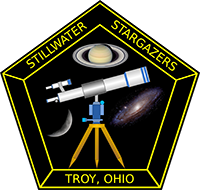Apologies, but the page you requested could not be found. Perhaps searching will help.
 209
209Stillwater Stargazers
We are astronomers in the Troy, Ohio area.
Stillwater Stargazers updated their status.3 days ago
This content isn't available right now
When this happens, it's usually because the owner only shared it with a small group of people, changed who can see it or it's been deleted.3 days ago
www.facebook.com/share/p/1FrvgSvXGC/🌕✨ THE MOON DANCES WITH SATURN & NEPTUNE📅 November 1–2, 2025
This weekend, the night sky becomes a cosmic stage — where the Moon, Saturn, and Neptune perform a rare celestial dance. 🌌
Look toward the southern sky after sunset, and you’ll see the bright Moon shining alongside two distant worlds: golden Saturn and icy-blue Neptune, glowing like twin beacons in the darkness.
🪐 What You’ll See:
Saturn — warm and golden, just above the horizon.
Neptune — faint but radiant in soft blue hues.
The Moon — lighting the scene with silver brilliance.
✨ Why It’s Special:
This alignment offers one of the most balanced contrasts in our solar system — the icy calm of Neptune, the golden warmth of Saturn, and Earth’s glowing Moon sharing one moment of harmony.
🔭 Best Time to Watch:
Just after dusk, when twilight fades and the stars begin to rise.
Find a dark, clear sky — and let the universe take your breath away.
🌍 The Earth Page — Where science meets wonder. ... See MoreSee Less
2 weeks ago
www.facebook.com/share/p/14PBsUFx52i/We may be living inside one of the largest known voids in the universe.Astronomers have long puzzled over the “Hubble Tension” – the fact that the universe appears to expand at different rates depending on how you measure it. Distant light from the early universe suggests a slower expansion, while local measurements from supernovae and Cepheid stars show a faster one.
Now, a study supports a striking possibility: Earth may be inside a 2-billion-light-year-wide void – a cosmic underdensity known as the KBC supervoid – and it might be distorting our measurements of the universe itself.
Here’s how it works: In standard cosmology, the universe is assumed to be roughly uniform on large scales – with galaxies, dark matter, and gas evenly spread. But the KBC supervoid violates that assumption. It’s an enormous region with fewer galaxies and less matter than average.
Light traveling from distant galaxies toward us passes through this low-density region. As it does, the gravitational influence of the void causes subtle changes in how the light stretches – an effect known as the Integrated Sachs-Wolfe effect. That stretch can make galaxies seem like they’re moving away from us faster than they are, skewing local estimates of the Hubble constant upward.
This might explain why local measurements show ~45 miles per second per megaparsec (73 km/s/Mpc), while early-universe data points to ~42 (67 km/s/Mpc).
But the implications go deeper.
According to the standard ΛCDM model – which includes dark energy and cold dark matter – a void this large and empty shouldn’t exist. That has led some researchers to explore alternative theories like Modified Newtonian Dynamics (MOND), which tweaks gravity instead of invoking invisible dark matter.
If confirmed, the KBC supervoid would be more than just a cosmic curiosity. It would mean our measurements of the universe’s expansion – and possibly even our theories of gravity – need a second look.
Read the study:
"A simultaneous solution to the Hubble tension and observed bulk flow within 250 h−1 Mpc." Monthly Notices of the Royal Astronomical Society, 2024. ... See MoreSee Less
3 months ago
Europe has levelled a mountain to build $1,000,000,000 telescope that will become largest optical telescope on Earth ... See MoreSee Lesswww.uniladtech.com
Multiple European nations have come together to build the largest optical telescope on Earth but it'll cost $1,000,000,000 and they have to level a mountain7 months ago
www.msn.com/en-us/news/technology/basics-of-astrophotography-everything-you-need-to-know-to-take-... ... See MoreSee LessBasics of Astrophotography | Everything You Need To Know To Take Your First Night Sky Photos, TODAY
www.msn.com
Photographing the Milky Way: a rite of passage for every landscape photographer, and truly the pinnacle of capturing the beauty of our planet. It doesn't have to be scary, and it certainly doesn't hav...



